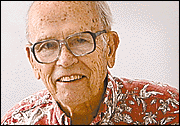Advertisement - Click to support our sponsors.


Hawaii’s World
Cayetano: Balance
First of three articles
needed on native issuesGOVERNOR Cayetano is deeply worried about the state of the public dialogue on Hawaiian affairs. We talked about it for more than two hours last week in two separate meetings in his office. He sees needed healthy discussion stifled by Hawaiian militants who denounce as "anti-Hawaiian" just about anything they disagree with.
We need a free public discussion -- including both Hawaiians and non-Hawaiians -- of what to do next, he feels, but don't have it because people fear being labeled anti-Hawaiian. In the absence of such discussion, many young Hawaiians are being turned angry and militant.
The governor has felt the lash himself. "I can take it intellectually, but it hurts emotionally," he said.
He puts considerable blame on the scholarly community in Hawaii, historians in particular, for not putting forth more balanced presentations of Hawaiian history, problems and issues. He could also blame the media. Accusations, unfortunately, grab both headlines and prime time.
Through its Center for Hawaiian Studies, the governor feels, the University of Hawaii teaches mainly the militant view of history espoused by its former director and current faculty member, Haunani-Kay Trask.
Trask's successor as director, Lilikala Kame'eleihiwa, has broken with her on some issues but the governor believes the needed balanced public discussion from the center still is lacking.
Trask's sister, Mililani, is an Office of Hawaiian Affairs trustee. She drew widespread criticism last year for her "one-armed bandit" characterization of Daniel K. Inouye, Hawaii's senior senator. Even Kame'eleihiwa lauded his work for Hawaiian advancement.
Cayetano recognizes Thurston Twigg-Smith, former owner-publisher of the Honolulu Advertiser, as having the bias of wanting to defend his grandfather, a principal figure in the 1893 overthrow, but agrees with Twigg-Smith that the lands of the monarchy were not stolen but conveyed through successive governments to the state of Hawaii.
THESE lands, amounting to about 1.4 million acres, are referred to as ceded lands. They include 200,000 acres of Hawaiian Homes lands and make up roughly one-third of the total land area of Hawaii.
The governor says many subjects of the Kingdom of Hawaii were non-Hawaiian, both Caucasian and Asian. Their descendants, too, might claim injury if the lands were stolen. In 1980, the state Legislature voted to give OHA 20 percent of all the rentals from these lands to benefit the 50,000 to 60,000 persons defined as native Hawaiians who have at least 50 percent Hawaiian blood.
Cayetano in 1980 was chairman of the state Senate Ways and Means Committee. He opposed the plan -- nevertheless adopted -- to give to the OHA one-fifth of the land rents from ceded lands.
Powerful House member Henry Peters argued it was "time to let Hawaiians win one for a change." Some legislators favored even more than 20 percent. Cayetano felt OHA should come before the Legislature for a budget, just like any other state department.
Congress specified the ceded lands must be used for five purposes: (1) public education, (2) the betterment of native Hawaiians of 50 percent blood quantum, (3) promotion of widespread farm and home ownership, (4) public improvements and (5) for other public uses. All citizens, Hawaiians included, benefit from the four general uses.
A.A. Smyser is the contributing editor
and former editor of the the Star-Bulletin
His column runs Tuesday and Thursday.